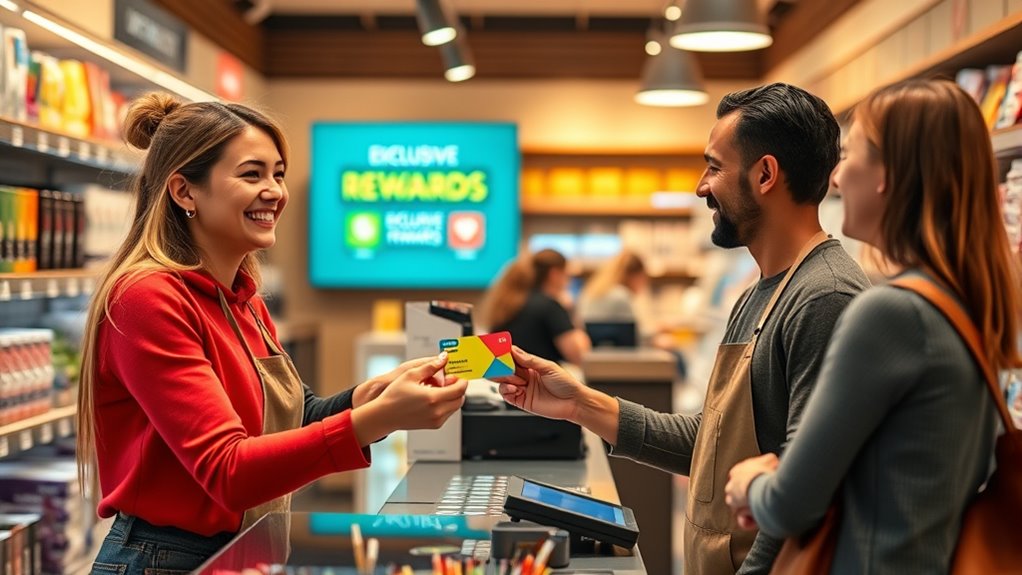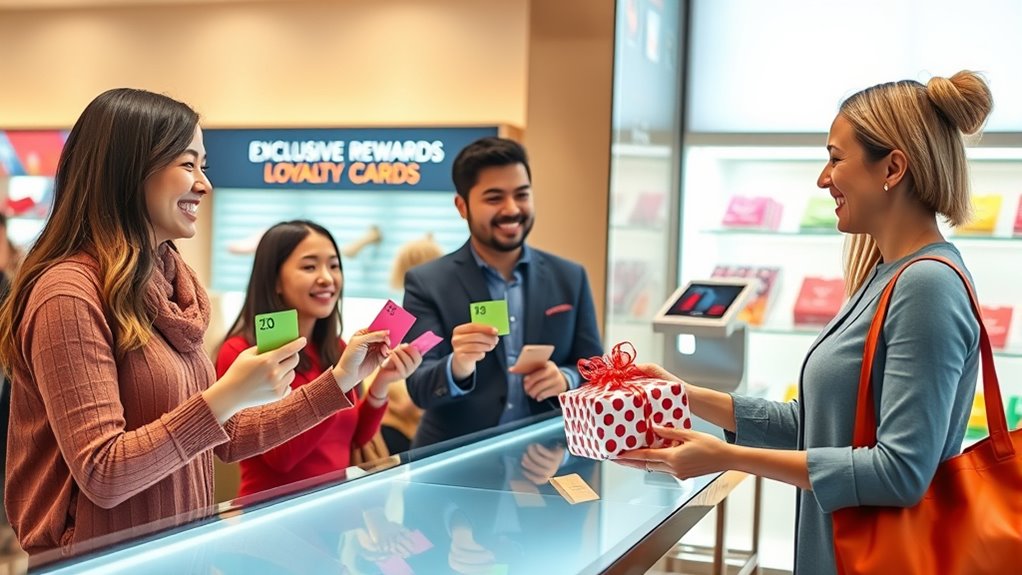To make customers love your brand and keep them coming back, create loyalty programmes that reward their efforts meaningfully. Focus on personalized rewards, clear communication, and easy redemption. Use tiered systems to motivate increased engagement and foster emotional connections through surprises and recognition. When customers feel valued and appreciated, they’re more likely to stay loyal and recommend you to others. Keep exploring ways to build stronger bonds that turn satisfaction into genuine loyalty.
Key Takeaways
- Design rewards that create a sense of progress, recognition, and personalization to foster emotional bonds and long-term loyalty.
- Ensure clear communication and easy redemption processes to build trust and demonstrate value to customers.
- Use tiered rewards and exclusive perks to motivate increased engagement and spending.
- Incorporate personalized offers and surprises to deepen emotional connections and make customers feel valued.
- Focus on delivering meaningful benefits consistently to turn satisfied customers into loyal advocates.

Have you ever wondered why some brands seem to attract your loyalty more than others? The key often lies in how they manage customer retention through effective reward structures. When a company understands what motivates you and designs its loyalty programmes accordingly, it creates a bond that keeps you coming back. Reward structures are the backbone of these programmes because they give you tangible incentives for your continued business. If you feel that your loyalty is genuinely valued and rewarded, you’re more likely to stick around, making repeat purchases without hesitation.
Effective reward structures foster customer loyalty by offering meaningful incentives and recognizing your ongoing engagement.
A well-crafted reward structure isn’t just about offering discounts or free products; it’s about creating a sense of progress and recognition. When you see your points accumulating with each purchase or receive personalized rewards based on your preferences, it feels less like a transactional exchange and more like a relationship. For example, some brands implement tiered rewards systems where your benefits grow as you spend more. This encourages you to increase your engagement because the more you invest, the better the perks become. It transforms a simple transaction into an experience that feels rewarding and exclusive.
Customer retention is directly influenced by how meaningful these reward structures are. If you feel that your loyalty leads to valuable benefits, you’re less likely to switch to competitors. The best programmes make it easy to redeem rewards and communicate the benefits clearly, so you always understand what you’re earning and how close you are to the next reward. When brands consistently deliver on their promises and make the process seamless, it builds trust and encourages ongoing loyalty.
Effective reward structures also tap into your emotional motivation. They can evoke feelings of appreciation, belonging, and recognition. When a company personalizes offers or surprises you with unexpected rewards, it deepens your emotional connection. This isn’t just about earning points; it’s about feeling valued as a customer. As a result, you’re more likely to recommend the brand to friends or become a brand advocate. Incorporating delayed gratification through rewards can further strengthen your commitment by encouraging continued engagement over time.
In the end, successful loyalty programmes understand that customer retention isn’t about one-off perks but about fostering a long-term relationship. Reward structures are the tools that nurture this relationship, turning satisfied customers into loyal ones. When a brand invests in meaningful rewards and creates an engaging experience, it elevates your perception of the company, making you want to stay loyal for the long haul. That’s how loyalty programmes make customers love you — by making every interaction feel rewarding and worth returning for.
Frequently Asked Questions
How Can Small Businesses Implement Effective Loyalty Programs?
To implement effective loyalty programs, you should focus on personalization strategies that make customers feel valued. Use reward tiers to encourage repeat business and provide incentives at different levels. Keep it simple and engaging, offering rewards that resonate with your audience. Communicate clearly about benefits, and regularly update your program to stay relevant. This approach builds trust and encourages customers to choose you over competitors.
What Are Common Mistakes to Avoid in Loyalty Program Design?
Think of designing a loyalty program as building a sturdy bridge—you want it strong and straightforward. Avoid complex reward structures that confuse your customers; keep the program simple so they understand its benefits. Don’t make the mistake of overcomplicating with too many tiers or unclear rules. Instead, focus on clarity and fairness, ensuring your rewards motivate without overwhelming, helping customers feel valued and enthusiastic to return.
How Do Loyalty Programs Influence Customer Lifetime Value?
Loyalty programs boost your customer lifetime value by encouraging repeat business and increasing spend. You can achieve this through reward segmentation and personalized incentives, making offers more relevant. When you tailor rewards based on customer preferences and behaviors, customers feel valued and motivated to stay loyal. This targeted approach deepens relationships, extends engagement, and ultimately, enhances their overall lifetime value with your brand.
What Digital Tools Assist in Managing Loyalty Programs?
Digital tools dramatically simplify managing loyalty programs. You can leverage mobile app integration to streamline sign-ups and track rewards effortlessly. Gamification strategies turn loyalty into a fun, engaging experience, encouraging ongoing participation. These tools provide real-time data, personalized offers, and seamless communication, helping you build better customer bonds. By combining gamification with mobile integration, you boost engagement, loyalty, and ultimately, customer lifetime value—all with smart, scalable digital solutions.
How Is Customer Data Protected in Loyalty Schemes?
You protect customer data in loyalty schemes by implementing data encryption, ensuring sensitive information stays secure during transmission and storage. You also follow strict privacy policies that define how data is collected, used, and shared, giving your customers confidence in your practices. Regularly updating security measures and training staff further safeguards data, showing you value their trust and comply with legal requirements.
Conclusion
A loyalty programme isn’t just about rewards; it’s about creating a relationship that feels personal and rewarding. While a simple discount might attract a one-time visit, genuine engagement keeps customers coming back, building trust and loyalty. Think of it like planting a seed—you could settle for quick growth or nurture a flourishing relationship. Ultimately, choosing meaningful, thoughtful programmes over fleeting perks transforms customers into lifelong fans, turning everyday transactions into lasting connections.






